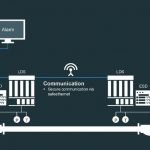Pipelines must fulfil strict requirements for safety, availability and environmental protection. Leaks are a considerable safety risk here. Aside from the dangers to people and the environment, the loss of reputation due to pipeline leaks can be very costly. In many cases, the losses due to clean-up tasks and fines are much greater than the actual loss of resources. Pipeline operators are well advised to employ a leak detection system for their facilities. In many countries, the implementation of best business practices for plant operation is mandatory. If an accident occurs, the operator is always at least partly responsible. Depending on the legal situation, the management may even be held personally liable if a pipeline is operated without a modern leak detection system. In addition, insurance companies may amend their policies according to the leak detection technology, increase premiums or refuse coverage if a suitable system is lacking.
Growing statutory requirements
Pipeline operators worldwide are also confronted by growing statutory requirements with regard to safety (SIL) and cyber security. They must already take a variety of international standards for pipeline integrity management into account. The two most important here are the U.S. standards API 1160, which provides general guidance on overall pipeline integrity management, and API 1130, which focuses specifically on leak monitoring. In Germany, the Technical Regulations for Pipelines (TRFL) must also be observed in relation to leak detection.
Moreover, new compliance topics arise from legislation such as the California Assembly Bill 864, which requires pipeline operators to deploy the best available technologies in environmentally sensitive areas in order to limit the amount of escaping oil in the event of an environmental disaster. This is the first instance where a combined leak localisation and safety system can actually be stipulated by law.
Problems with false alarms
The four biggest challenges facing pipeline operators when it comes to leak detection systems are excessive false alarms, failure to detect leaks, an inability to localise them and costly or complicated maintenance.
In a horizontal pipeline, there is a steady flow with a constant volumetric flow rate and a linear pressure drop along the pipe length. A leak changes the hydraulic behaviour of the pipeline: the flow rate is higher before the leak than after it. As a result, the pressure drop upstream of the leak is steeper than downstream. The pressure also declines slightly at both ends of the pipeline. A leak detection system attempts to recognise these features and determine whether an unplanned outflow is present and if so, where it is located.
In practice, conventional leak detection systems using only pressure sensors often generate false alarms. This is because a detected pressure drop in the pipeline does not always mean that a leak is present; it can also result from operational factors. Such systems are generally prone to measurement errors and are dependent on the positioning of the sensors.
Hybrid solution
The FlexSILon PMC pipeline management solution, the first to combine leak management with emergency shutdown, not only protects the facilities concerned but also controls and manages safety-relevant processes. The key components of this integrated hybrid solution are the SIL3 safety system and the leak detection and localisation system.
Flow rate monitoring takes place directly in the SIL3-capable Himax safety hardware, with pressure and temperature data transmitted to the control centre for visualisation using Hima’s proprietary, secure SafeEthernet protocol. The Himax systems are also connected to each other over SafeEthernet. Each system therefore knows the state of the pipeline overall. If a leak occurs, the Himax controller automatically adjusts the flow and in an emergency shuts down the pipeline immediately. This way, the system can prevent or significantly reduce damage. The safety controller is based on Hima’s XMR technology, which combines SIL3 safety hardware and software with a scalable, fault-tolerant architecture in order to avoid false alarms.
An important part of FlexSILon PMC is the FLOWorX software for leak detection and localisation. This enables operators to constantly keep an eye on flow rates, pressures and temperatures in their pipelines. Anomalies are reliably recognised. The system also supports pressure and temperature correction calculations. The FLOWorX software can additionally detect pipeline rupture, in which case the damaged pipeline section is automatically shut down.
Operators can adapt the detection algorithms flexibly to their specific needs. Unlimited changes and even prescribed verification tests during ongoing system operation according to the SIL3 standard are possible. Thanks to the open interfaces, the system can be integrated into virtually any automation environment. Along with the automation components necessary for management, control and monitoring of gas and liquid pipelines, the package also includes customer support and service.
Precise leak localisation
The SIL3-capable leak localisation system conforms to all relevant standards, including API 1130 and TRFL. To ensure continuous system availability, leaks are simultaneously analysed and localised by several methods. The extended pressure wave method, the volume/mass balance method and the pressure drop method are used either individually or in combination, depending on the nature of the damage and the operating state of the pipeline.
This methodology ensures reliable detection of even the smallest leaks and minimises false alarms. For example, the extended pressure wave method increases the system’s detection sensitivity, allowing leaks as small as a 0.35 % pressure change to be detected. This high accuracy eliminates over 80 % of all false alarms. Furthermore, leak detection is so precise that even resource theft is visualised.
Safety systems also address security
Pipelines are increasingly targeted by hackers. Very few safety systems are prepared for this. By contrast, FlexSILon PMC meets all relevant requirements for cyber security. The safety controller offers several protection options for secure communication. For example, CPU and communication tasks are structurally partitioned. Using Hima’s own hardware and software with the proprietary operating system makes access considerably more difficult for hackers. In addition, there is no need for the time-consuming patches commonly required with current standard software.
The FlexSILon PMC hybrid solution allows pipeline operators to implement both safety and critical control applications in compliance with all essential standards. It significantly increases the safety and profitability of pipelines by quickly and accurately detecting and localising leaks. False alarms and downtime are reduced to a minimum. Operators benefit from higher availability over the entire pipeline lifecycle as well as lower liability exposure and less risk of consequential costs, while avoiding environmental damage and loss of reputation. The combination of functional safety and information security increases the overall safety and security of the facility.
Suchwort: cavPC117hima
Author : Hartmut Leistner
Sales Director Germany, Austria & Switzerland,
Hima









